Numerical Analysis of the Installation Process of Screw Piles Based on the FEM-SPH Coupling Method
Abstract
:1. Introduction
2. Basic Theory of SPH
2.1. Solution of the SPH
2.2. FEM-SPH Coupling Algorithm
3. Numerical Simulations
3.1. Numerical Model
3.2. Influence of the Size of the Soil Model
3.3. Verification of the Soil Model
3.4. Verification of the FEM-SPH Model
3.5. Comparison between the FEM-SPH Method and FEM
4. Numerical Results
4.1. Analysis of the Installation Process of Screw Piles
4.1.1. Analysis of the Installation Process in the Shallow Soil
4.1.2. Analysis of the Installation Process in the Middle Soil
4.1.3. Analysis of the Installation Process in the Deep Soil
4.2. Influence of Pile Structure Parameters on Soil Displacement
4.3. Influence of Pile Structure Parameters on Soil Pressure
4.4. Influence of Pile Structure Parameters on Soil Stress
5. Conclusions
- (1)
- By comparing with the experimental results, the accuracy of the FEM-SPH coupling model is verified. FEM-SPH simulation results show a better agreement with the experimental results in terms of the installation torque and the soil deformation of the ground surface, indicating that the FEM-SPH method has good applicability in dealing with the large deformation caused by the installation of the screw pile.
- (2)
- Compared to the traditional FE (AlE) method, the FEM-SPH method possesses better efficiency and accuracy at the same time, which is more suitable for simulating the large deformation problem caused by the installation of the screw pile.
- (3)
- The FEM-SPH numerical model was used to analyze the installation process of the screw pile. The numerical results show that the interaction during the installation process between the screw pile and the surrounding soil is transferable, and the load transfer occurs throughout the installation of the screw pile. With the increase in the installation depth, the extent of damage to the soil caused by the screw pile will decrease. The installation of the screw pile results in heave damage to the shallow soil and exhibits cylindrical shear damage to the middle and deeper layers.
- (4)
- Based on the developed numerical model, the variability in the installation process of different screw piles was analyzed. The analysis shows that the two failure mechanisms (HFM and CSFM) have different effects on the soil during the installation of the screw pile. For HFM and CSFM caused by the installation of the screw pile, the influence range on the soil around the pile of HFM is only related to the pile diameter and is irrelevant to the spiral pitch. Unlike HFM, the influence range on the soil around the pile of CSFM is affected by the variations in both spiral pitch and pile diameter.
Author Contributions
Funding
Institutional Review Board Statement
Informed Consent Statement
Data Availability Statement
Conflicts of Interest
References
- Chen, Y.D.; Deng, A.; Lu, F.; Sun, H.S. Failure mechanism and bearing capacity of vertically loaded pile with partially-screwed shaft: Experiment and simulations. Comput. Geotech. 2020, 118, 103337. [Google Scholar]
- Livneh, B.; Ei Naggar, M.H. Axial testing and numerical modeling of square shaft helical piles under compressive and tensile loading. Can. Geotech. J. 2008, 45, 1142–1155. [Google Scholar]
- Ghaly, A.; Hanna, A. Experimental and theoretical studies on installation torque of screw anchors. Can. Geotech. J. 1991, 28, 353–364. [Google Scholar]
- Al-Baghdadi, T. Screw Piles as Offshore Foundations: Numerical and Physical Modelling. Ph.D. Thesis, University of Dundee, Dundee, UK, 2018. [Google Scholar]
- Shao, K.; Su, Q.; Liu, K.; Shao, G.; Zhong, Z.; Li, Z.; Chen, C. A new modified approach to evaluating the installation power of large-diameter helical piles in sand validated by centrifuge and field data. Appl. Ocean. Res. 2021, 114, 102756. [Google Scholar]
- Sakr, M. Relationship between Installation Torque and Axial Capacities of Helical Piles in Cohesive Soils. J. Deep. Found. Inst. 2013, 7, 44–45. [Google Scholar]
- Sakr, M. Relationship between Installation Torque and Axial Capacities of Helical Piles in Cohesionless Soils. Can. Geotech. J. 2014, 52, 747–759. [Google Scholar]
- Perko, H.A. Energy Method for Predicting Installation Torque of Helical Foundations and Anchors. J. Econ. Psychol. 2000, 5, 49–70. [Google Scholar]
- Guo, Z.; Deng, L. Field behavior of screw micropiles subject to axial loading in cohesive soils. Can. Geotech. J. 2018, 55, 34–44. [Google Scholar]
- Harnish, J.L. Helical Pile Installation Torque and Capacity Correlations. J. Cutan. Pathol. 2015, 24, 457–460. [Google Scholar]
- Jabur, J.A.; Mahmood, M.R.; Abbas, S.F. The Effect of installation Torque on the Behavior of Helical Piles under Compression Load Tested by Centrifuge Device. IOP Conf. Ser. Mater. Sci. Eng. 2021, 1094, 012091. [Google Scholar]
- Markou, A.A.; Kaynia, A.M. Nonlinear soil-pile interaction for offshore wind turbines. Wind Energy 2018, 21, 558–574. [Google Scholar]
- Galindo, P.G.; Davidson, C.; Brown, M.J. Installation behavior of open ended and closed ended piles with torque application. In Proceedings of the International Conference on Press-In Engineering First International Conference, Kochi, India, 19–20 September 2018; International Press-In Association: Tokyo, Japan, 2018; pp. 379–386. [Google Scholar]
- Nowkandeh, M.J.; Choobbasti, A.J. Numerical study of single helical piles and helical pile groups under compressive loading in cohesive and cohesionless soils. Bull. Eng. Geol. Environ. 2021, 80, 4001–4023. [Google Scholar]
- Alwalan, M.F.; El Naggar, M.H. Finite element analysis of helical piles subjected to axial impact loading. Comput. Geotech. 2020, 123, 103597. [Google Scholar]
- Akopyan, V.; Akopyan, A. Experimental and Theoretical Investigation of the Interaction of the Reinforced Concrete Screw Piles with the Surrounding Soil. Procedia Eng. 2016, 150, 2202–2207. [Google Scholar]
- Shi, D.D.; Yang, Y.C.; Deng, Y.B.; Xue, J.F. DEM modelling of screw pile penetration in loose granular assemblies considering the effect of drilling velocity ratio. Granul. Matter 2019, 21, 1–16. [Google Scholar]
- George, B.E.; Banerjee, S.; Gandhi, S.R. Helical Piles Installed in Cohesionless Soil by Displacement Method. Int. J. Geomech. 2019, 19, 1–18. [Google Scholar]
- Elsherbiny, Z.H.; Naggar, M. Axial compressive capacity of helical piles from field tests and numerical study. Can. Geotech. J. 2013, 50, 1191–1203. [Google Scholar]
- Malik, A.A.; Kuwano, J.; Tachibana, S.; Maejima, T. End bearing capacity comparison of screw pile with straight pipe pile under similar ground conditions. Acta Geotech. 2017, 12, 415–428. [Google Scholar]
- Gavin, K.; Doherty, P.; Tolooiyan, A. Field investigation of the axial resistance of helical piles in dense sand. Can. Geotech. J. 2014, 51, 1343–1354. [Google Scholar]
- Kurian, N.P.; Shah, S.J. Studies on the behavior of screw piles by the finite element method. Can. Geotech. J. 2009, 46, 627–638. [Google Scholar]
- Ghasemzadeh, H.; Alibeikloo, M. Pile–soil–pile interaction in pile groups with batter piles under dynamic loads. Soil Dyn. Earthq. Eng. 2011, 31, 1159–1170. [Google Scholar]
- Xiao, H.B.; Zhang, C.S.; Wang, Y.H.; Fan, Z.H. Pile-Soil Interaction in Expansive Soil Foundation: Analytical Solution and Numerical Simulation. Int. J. Geomech. 2011, 11, 159–166. [Google Scholar]
- Rui, Y.; Yin, M. Investigations of pile–soil interaction under thermo-mechanical loading. Can. Geotech. J. 2018, 55, 1016–1028. [Google Scholar]
- Nassiri, S.; Chen, Z.; Lamanna, A.; Cofer, W. Numerical simulation of failure mechanism in screw anchors under static tension. Adv. Struct. Eng. 2020, 23, 3385–3400. [Google Scholar]
- Ho, H.M.; Malik, A.A.; Kuwano, J.; Rashid, H.M.A. Influence of helix bending deflection on the load transfer mechanism of screw piles in sand: Experimental and numerical investigations. Soils Found. 2021, 61, 874–885. [Google Scholar]
- Goodin, C.; Priddy, J.D. Comparison of SPH simulations and cone index tests for cohesive soils. J. Terramech. 2016, 66, 49–57. [Google Scholar]
- Wang, W.; Wu, Y.J.; Wu, H.; Yang, C.Z.; Feng, Q.S. Numerical analysis of dynamic compaction using FEM-SPH coupling method. Soil Dyn. Earthq. Eng. 2021, 140, 106420. [Google Scholar]
- Lu, Z.; Jin, Z.; Kotronis, P. Numerical analysis of slope collapse using SPH and the SIMSAND critical state model. J. Rock Mech. Geotech. Eng. 2022, 14, 169–179. [Google Scholar]
- Soleimani, M.; Weißenfels, C. Numerical simulation of pile installations in a hypoplastic framework using an SPH based method. Comput. Geotech. 2021, 133, 104006. [Google Scholar]
- Kishi, N.; Kurihashi, Y.; Ghadimi Khasraghy, S.; Mikami, H. Numerical simulation of impact response behavior of rectangular reinforced concrete slabs under falling-weight impact loading. Appl. Mech. Mater. 2011, 82, 266–271. [Google Scholar]
- Bolton, M.D.; Gui, M.W.; Garnier, J.; Corte, J.F.; Bagge, G.; Laue, J.; Renzi, R. Centrifuge cone penetration tests in sand. Géotechnique 1999, 49, 543–552. [Google Scholar] [CrossRef] [Green Version]
- Lehane, B.M. CPT-based design of foundations. E.H. Davis Memorial Lecture. Aust. Geomech. 2017, 54, 23–48. [Google Scholar]
- Li, L.; Zheng, M.; Liu, X.; Wu, W.; Liu, H.; El Naggar, M.H.; Jiang, G. Numerical analysis of the cyclic loading behavior of monopile and hybrid pile foundation. Comput. Geotech. 2022, 144, 104635. [Google Scholar]
- Li, L.C.; Liu, H.; Wu, W.B.; Wen, M.J.; El Naggar, M.H.; Yang, Y.Z. Investigation on the behavior of hybrid pile foundation and its surrounding soil during cyclic lateral loading. Ocean Eng. 2021, 240, 110006. [Google Scholar]
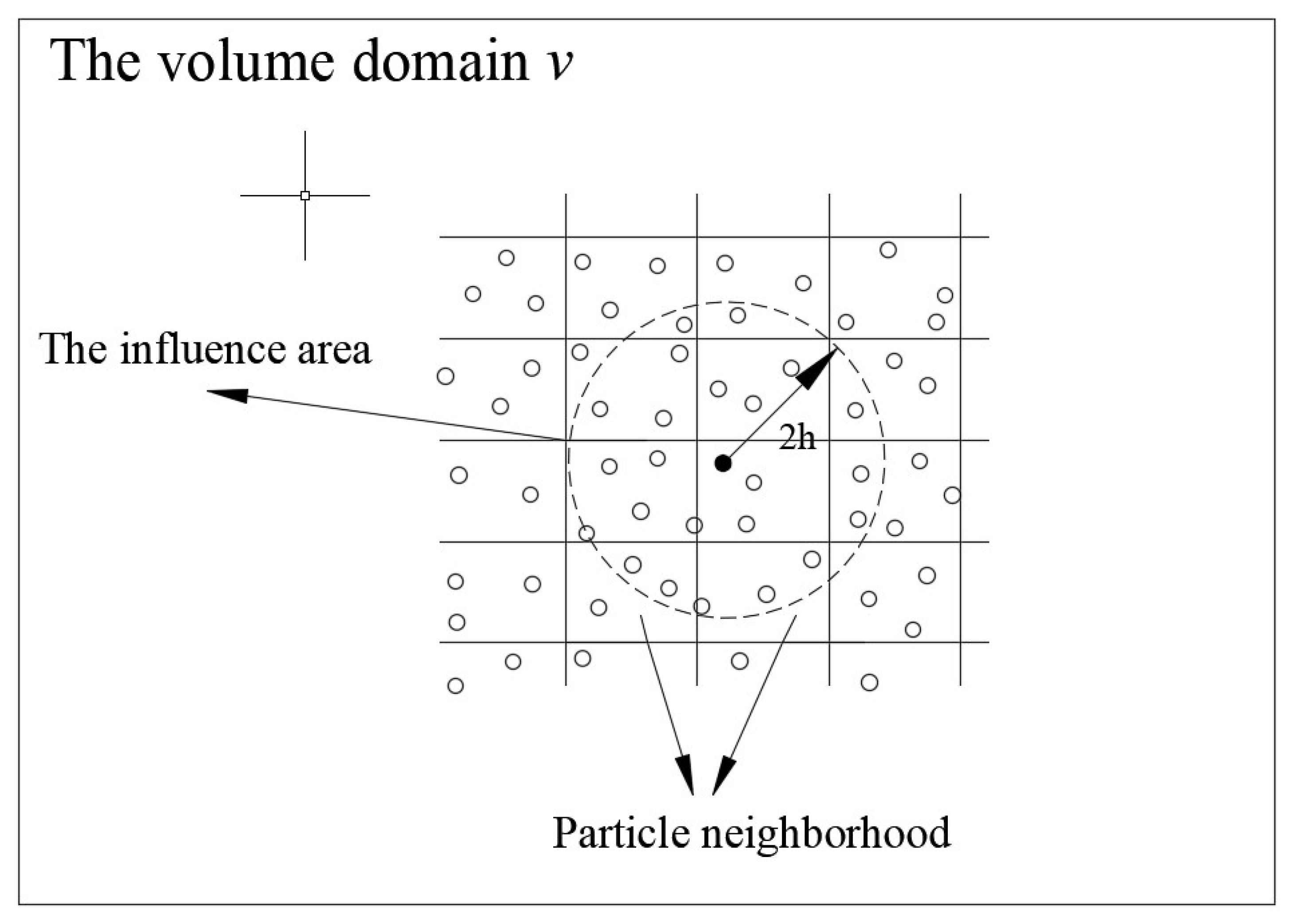

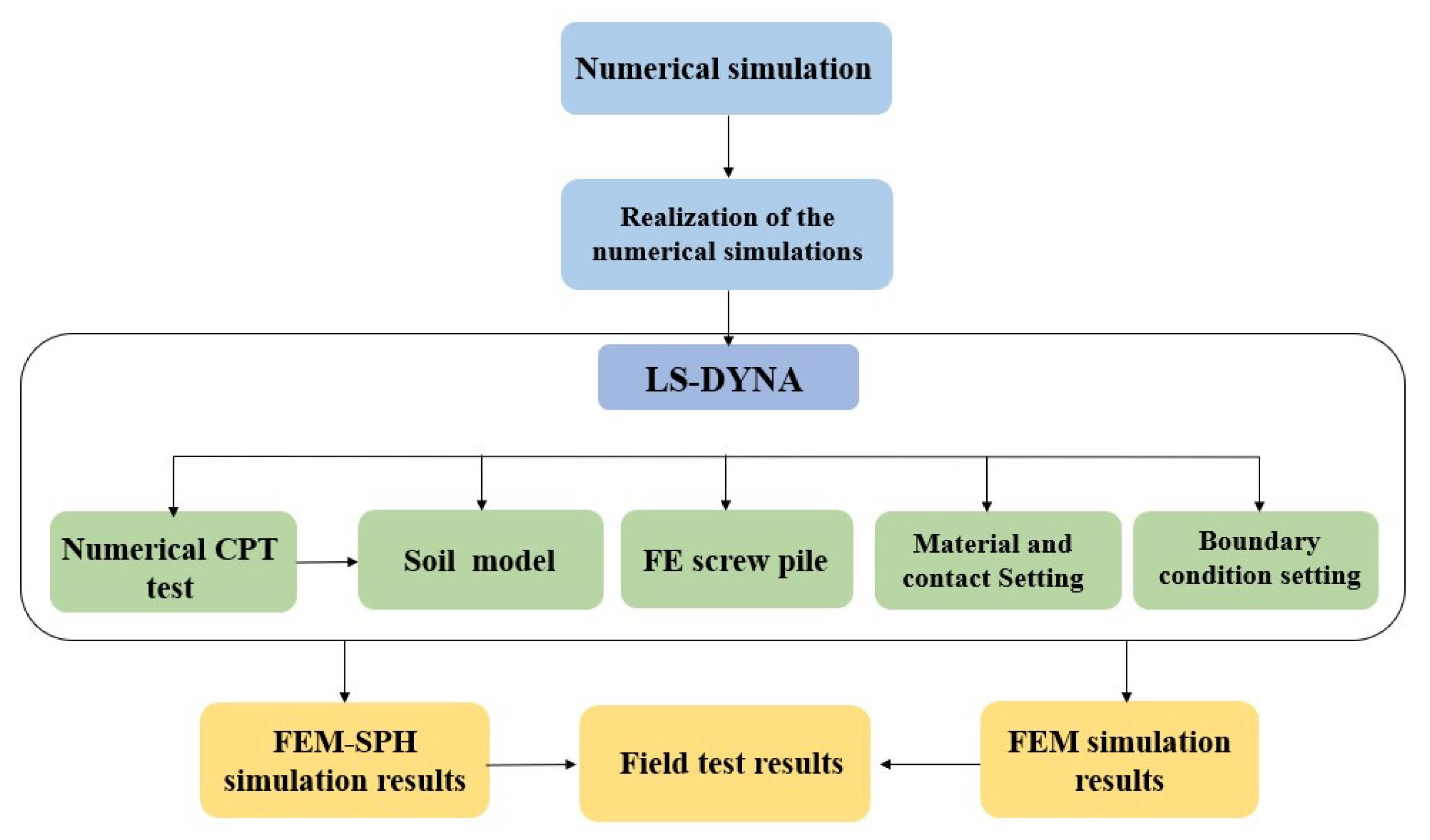
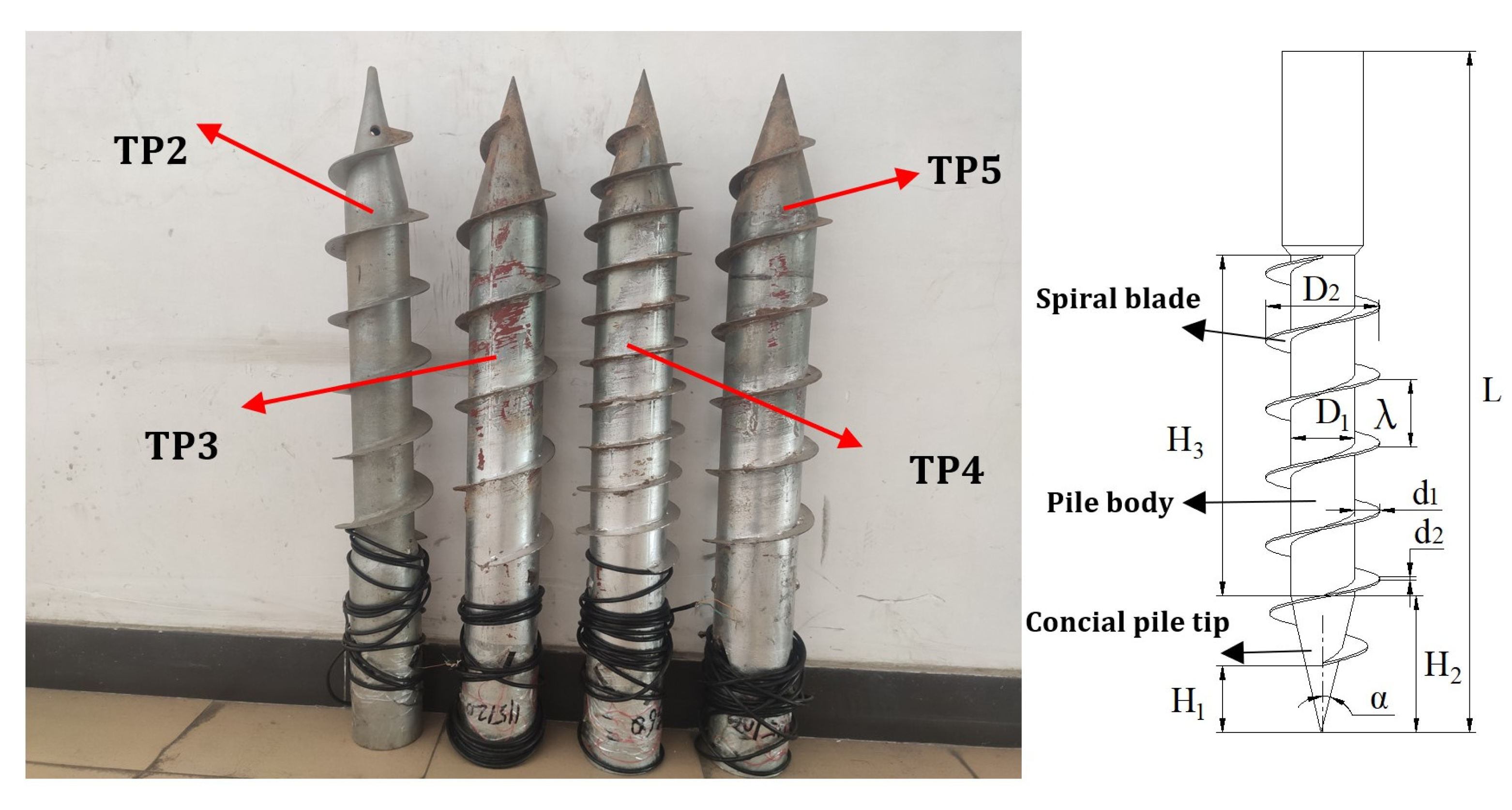
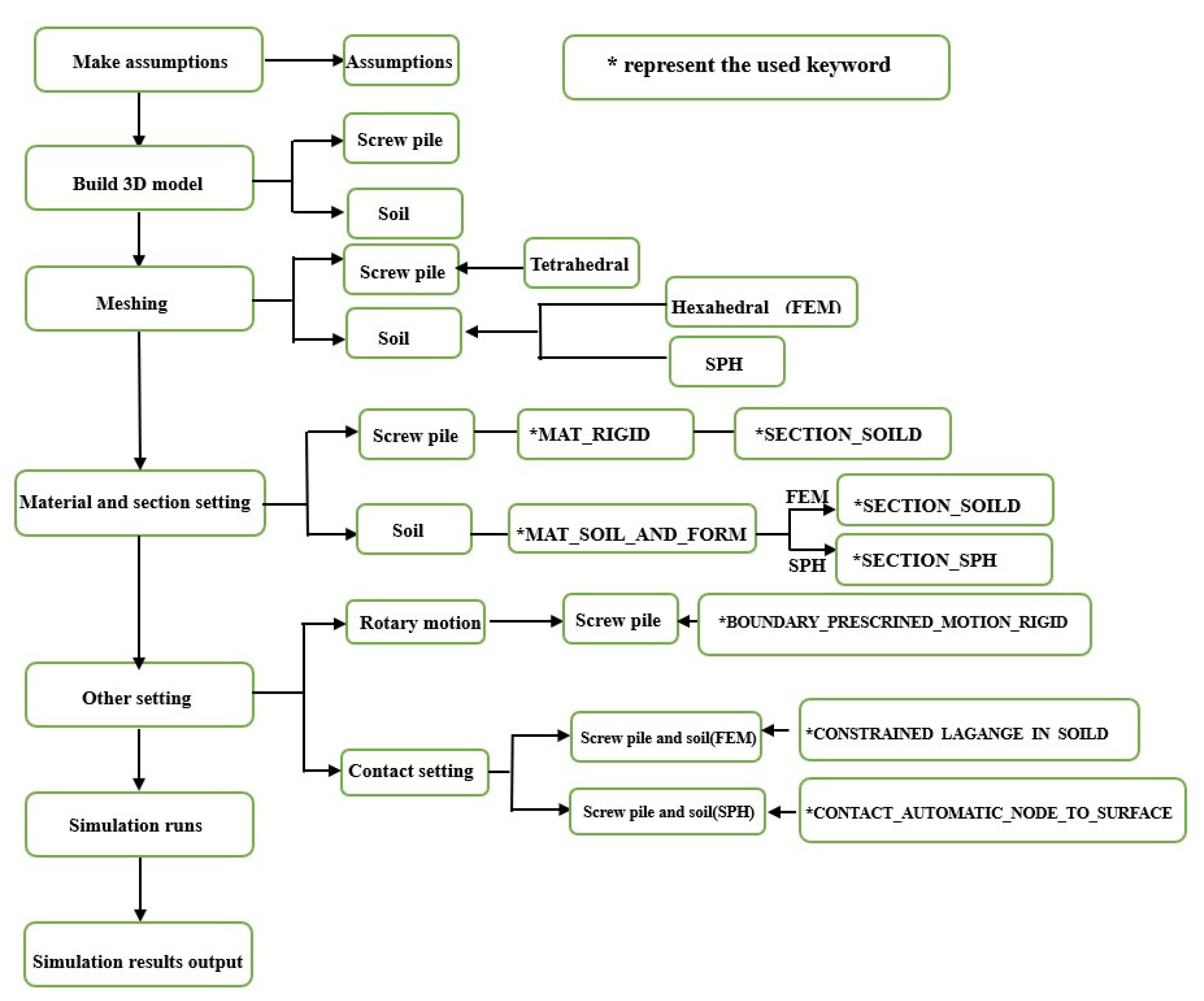

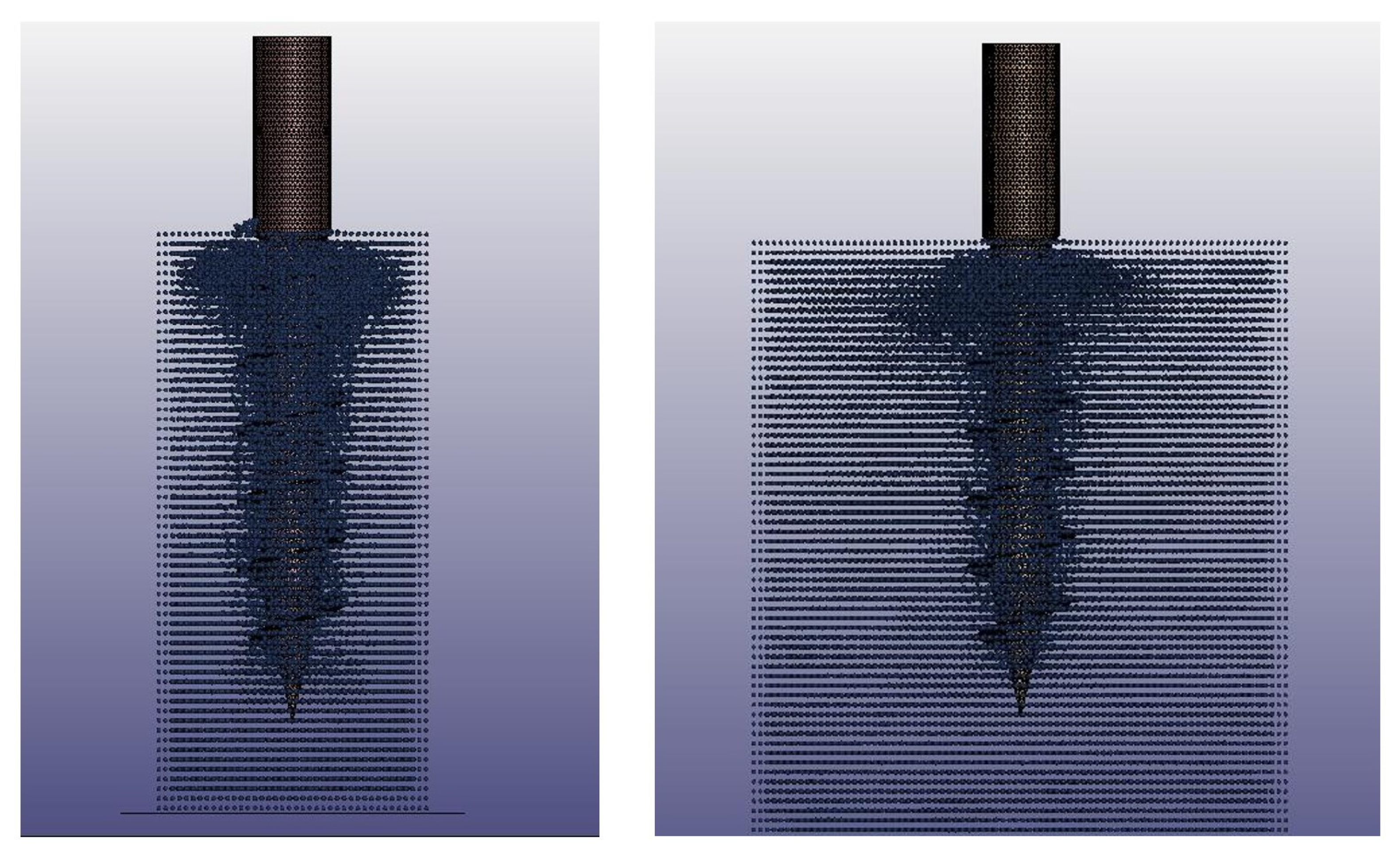


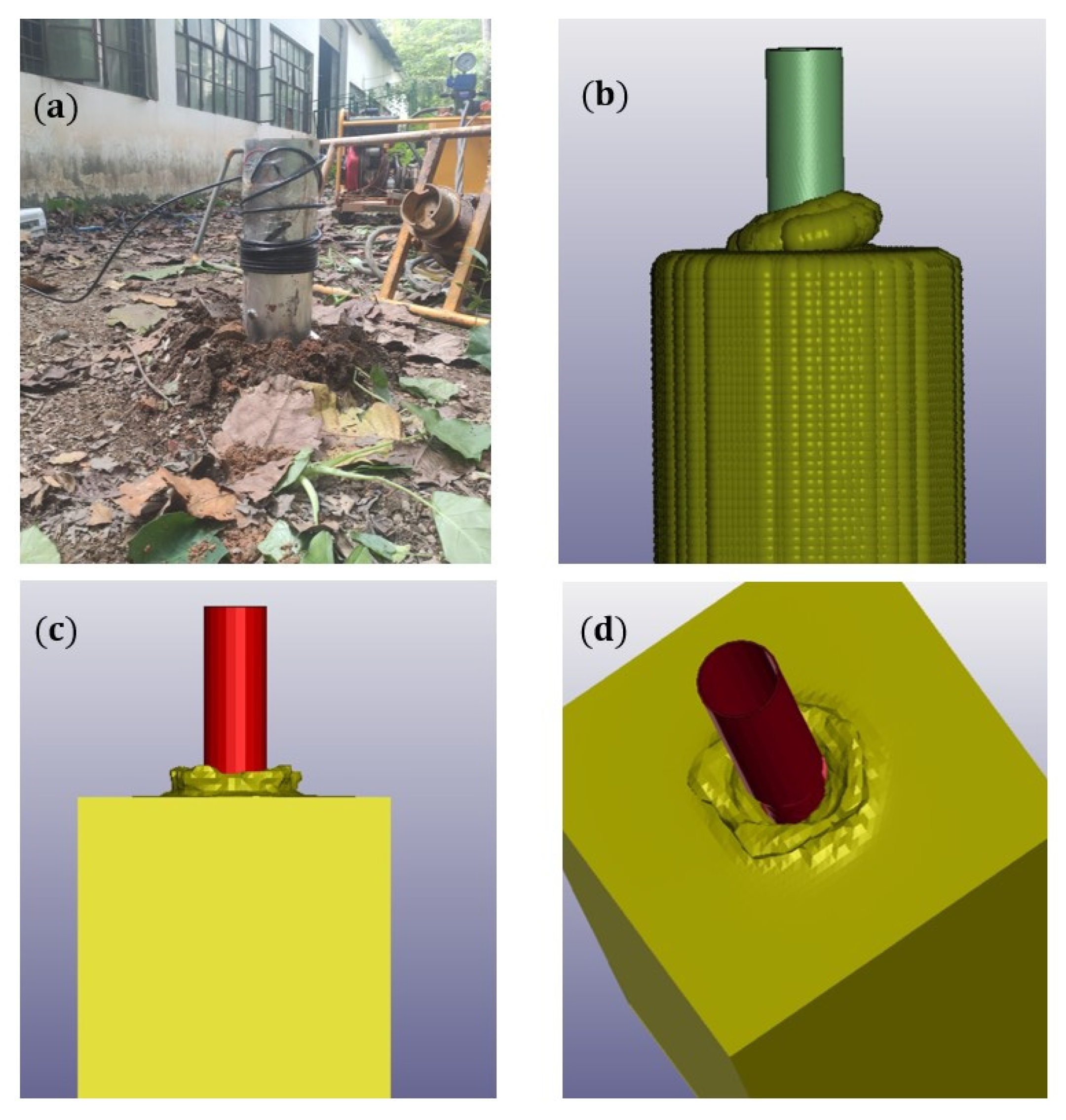

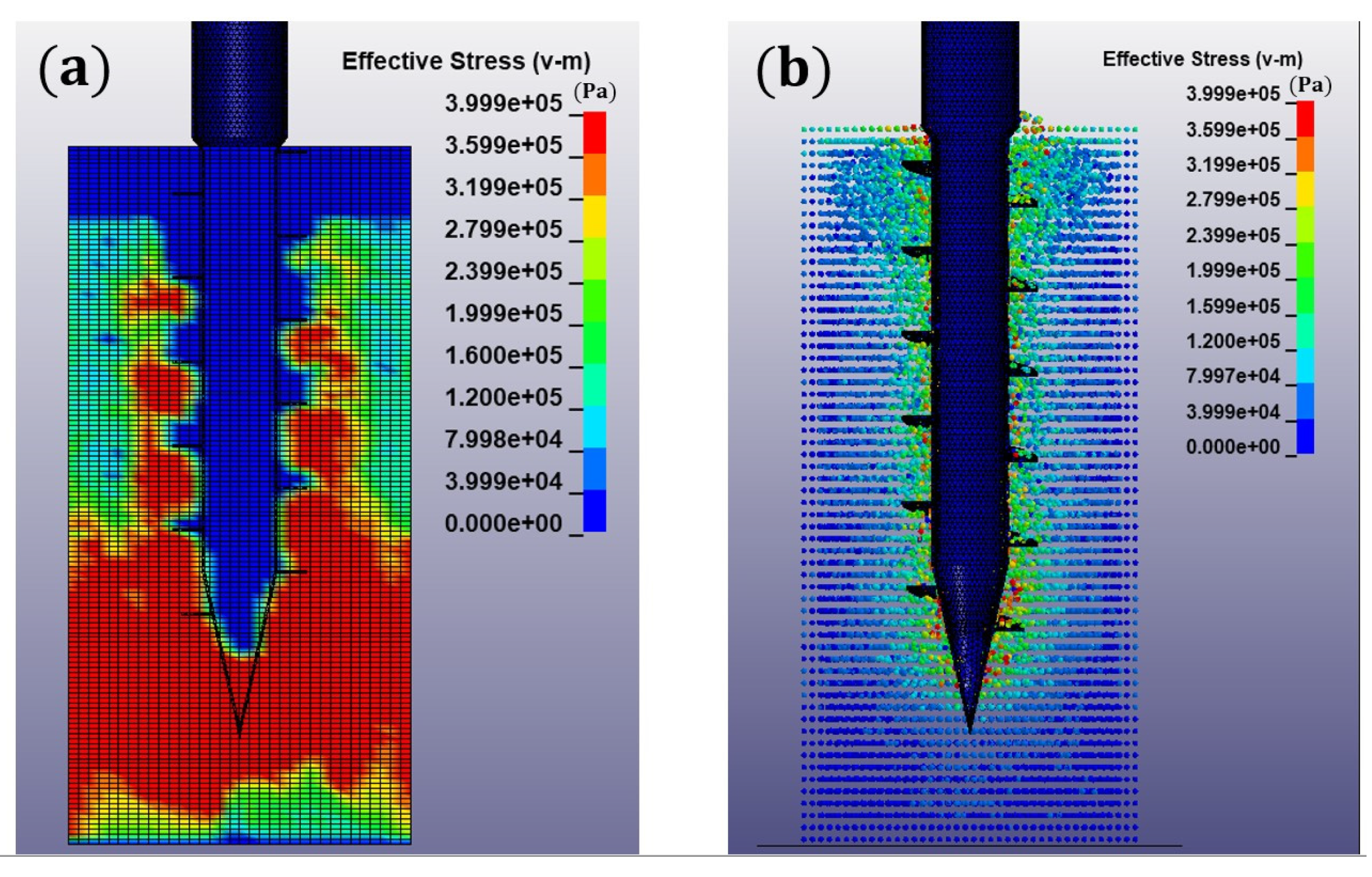
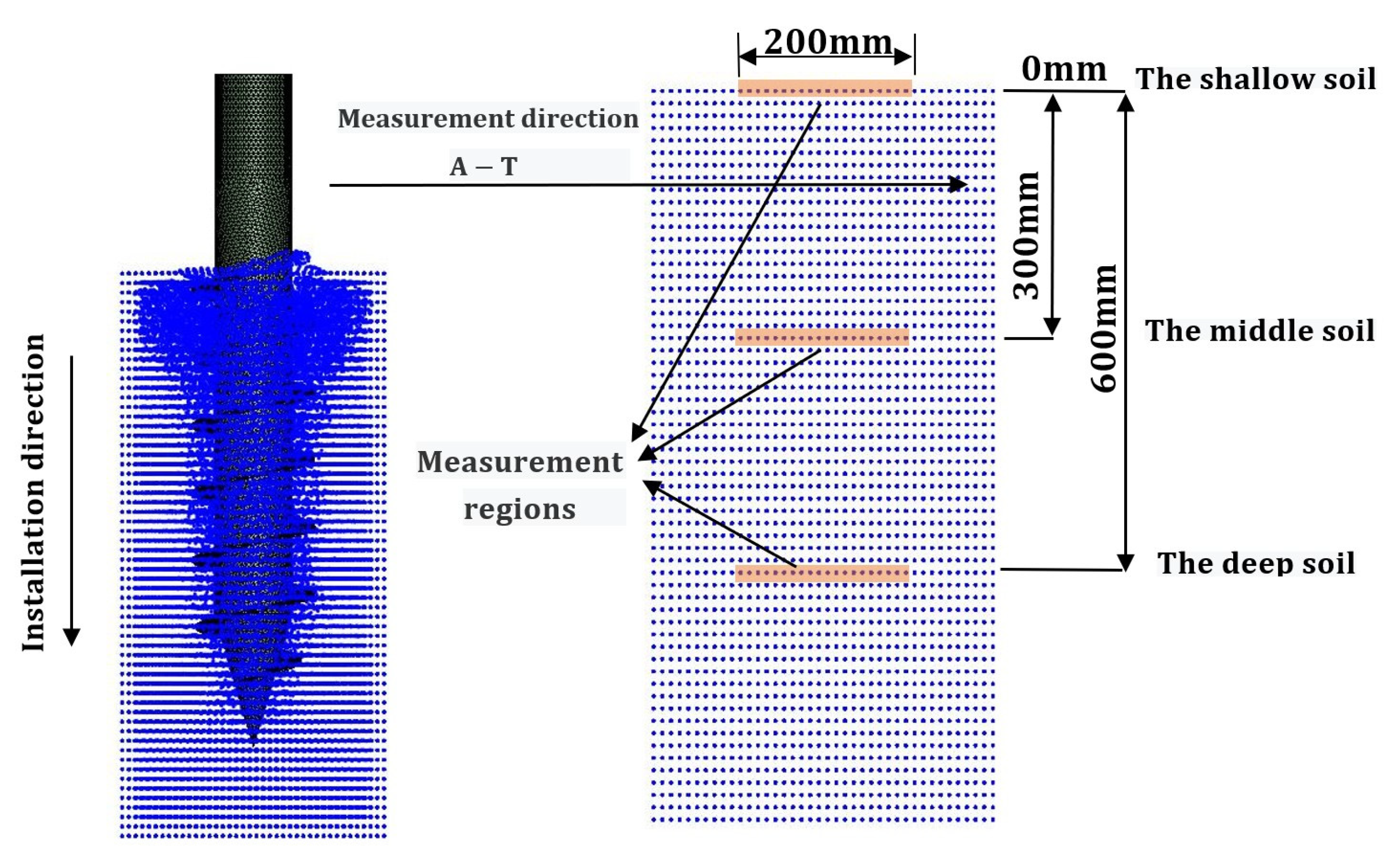

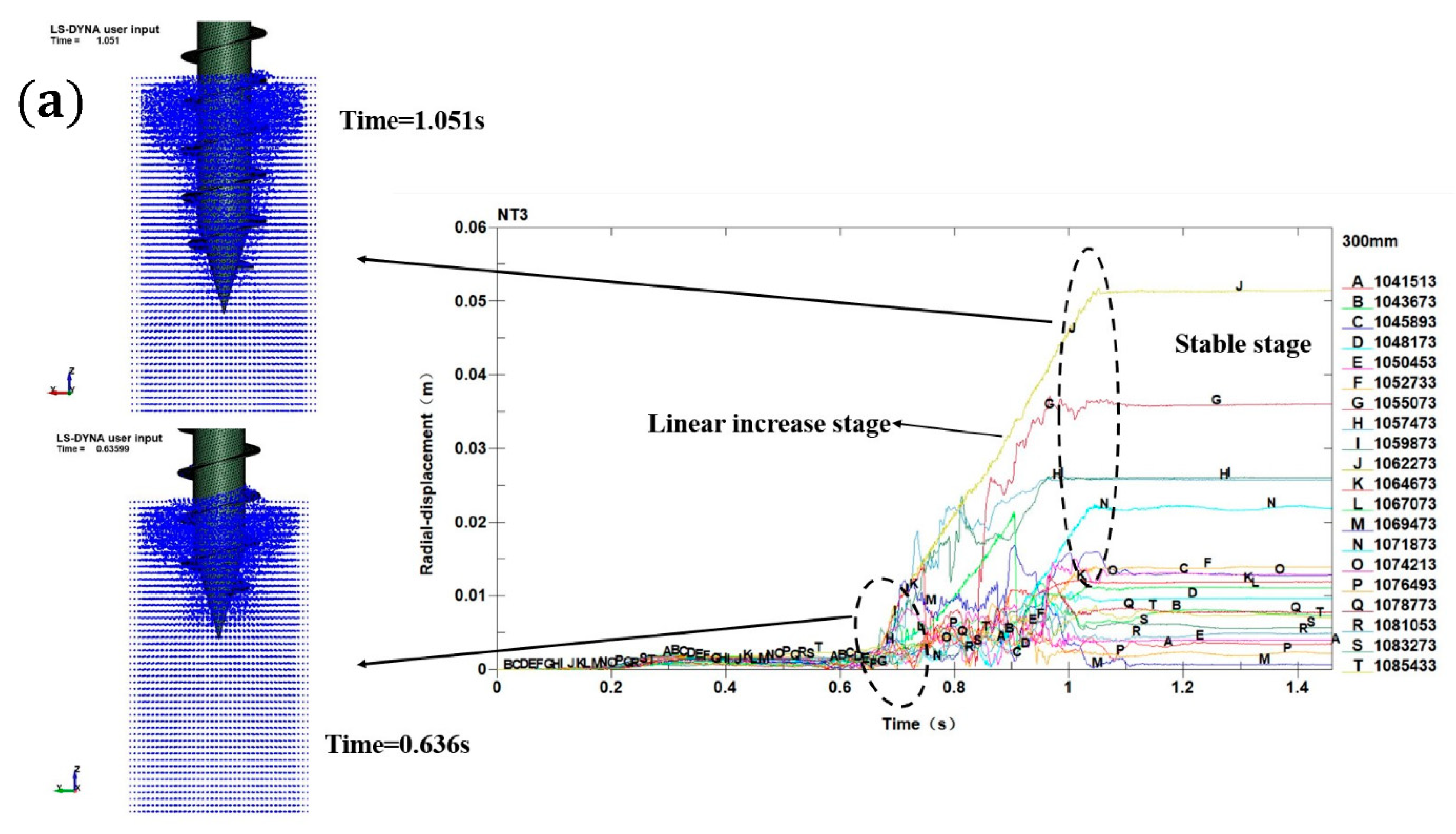


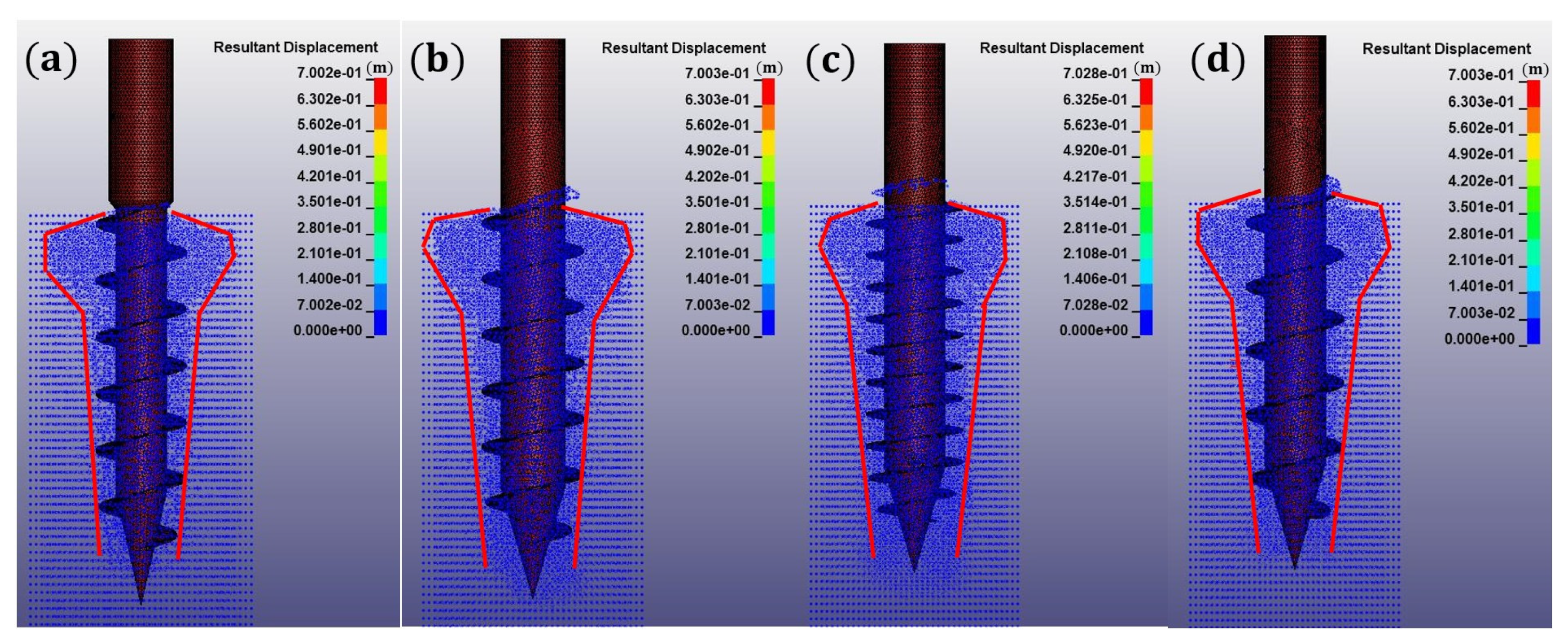


| 1850 | 20 | 0.3 | 20 | 7.7 | 16.7 |
| Number | |||||||||
|---|---|---|---|---|---|---|---|---|---|
| TP2 | 1000 | 90 | 150 | 100 | 200 | 500 | 50 | 3 | 30 |
| TP3 | 1000 | 115 | 175 | 100 | 200 | 500 | 50 | 3 | 30 |
| TP4 | 1000 | 115 | 165 | 60 | 200 | 500 | 50 | 3 | 25 |
| TP5 | 1000 | 115 | 165 | 120 | 200 | 500 | 50 | 3 | 25 |
| Material | |||
|---|---|---|---|
| Q235 | 7800 | 2.1 × 105 | 0.3 |
Publisher’s Note: MDPI stays neutral with regard to jurisdictional claims in published maps and institutional affiliations. |
© 2022 by the authors. Licensee MDPI, Basel, Switzerland. This article is an open access article distributed under the terms and conditions of the Creative Commons Attribution (CC BY) license (https://creativecommons.org/licenses/by/4.0/).
Share and Cite
Zhao, Q.; Wang, Y.; Tang, Y.; Ren, G.; Qiu, Z.; Luo, W.; Ye, Z. Numerical Analysis of the Installation Process of Screw Piles Based on the FEM-SPH Coupling Method. Appl. Sci. 2022, 12, 8508. https://doi.org/10.3390/app12178508
Zhao Q, Wang Y, Tang Y, Ren G, Qiu Z, Luo W, Ye Z. Numerical Analysis of the Installation Process of Screw Piles Based on the FEM-SPH Coupling Method. Applied Sciences. 2022; 12(17):8508. https://doi.org/10.3390/app12178508
Chicago/Turabian StyleZhao, Qingxu, Yuxing Wang, Yanqin Tang, Guofeng Ren, Zhiguo Qiu, Wenhui Luo, and Zilong Ye. 2022. "Numerical Analysis of the Installation Process of Screw Piles Based on the FEM-SPH Coupling Method" Applied Sciences 12, no. 17: 8508. https://doi.org/10.3390/app12178508






